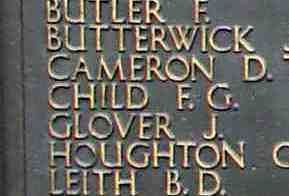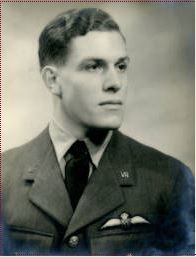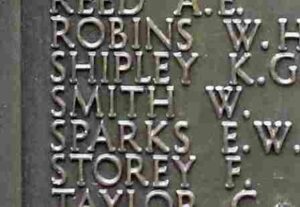Cwmtydu is a small village situated on the picturesque Cardigan coast, between Llangrannog and New Quay, overlooking Cardigan Bay. The Parish Church, dedicated to St Tyssilio, contains three memorial plaques; one to the Parishioners who fell during World War Two, one to Sister Grace Evans, and one to Captain J. A. Jones. Many thanks to Mike Berrell for the photographs of the memorials.
The Great War, 1914-1918
Grace Evans, Sister, Queen Victoria Hospital. Grace was born in 1879, the daughter of Francis and Mary Evans, and the sister of Francis Evans, of Llwyndafydd, and the wife of Captain William Nott. She was a Nurse, and had served at Queen Victoria Hospital during the Great War, treating men who had been wounded or become ill during the campaign in German East Africa. Grace survived the war, but it took a heavy toll on her health, as she died at Johannesburg on 16 November 1930. The plaque below is in St Tysilio Church.

James Arthur Jones, MID, Captain, South Wales Borderers. James was born in 1890, the son of the Reverend James Jones and of Jane Jones (nee Thomas), of Hill Cottage, Heywood Lane, Tenby. He enlisted into the South Wales Borderers soon after the outbreak of war and was commissioned into the 10th Battalion, South Wales Borderers, which was at Colwyn Bay attached to the 43rd (Welsh) Division. The Division trained in North Wales before moving to Winchester in the summer of 1915, where the formation became renumbered 115 Brigade, 38th (Welsh) Division. The Division began moving to France on 2 December 1915 and moved to the Nursery Sector near Fleurbaix for trench initiation alongside the Guards Division. The Division then held a sector of the line near Cuinchy before marching south to the Somme sector in June 1916 to take part in the assault on Mametz Wood. The first attack on the wood was launched on a two-battalion front on 7 July, but failed, and the Divisional Commander, Sir Ivor Philipps, was replaced before the Division attacked again on a two Brigade front on 10 July 1916. After two days of ferocious hand-to-hand fighting, the wood was cleared up to its northern edge, before the battered Division was relieved. It then took over a section of the front at Hébuterne before moving to the Ypres Salient and taking over the Canal Bank sector at Boesinghe. The infantry battalions of the Division then began carrying out the normal pattern of rotation in the trenches, four days in the front, four in support and four in reserve, whilst also working on trench improvement, digging new trenches, and carrying out regular patrols and trench raids. On 31 July 1917 the Division launched its famous assault on the Pilckem Ridge, capturing Iron Cross and reaching its objective of the Steenbeek, then played a supporting role in the Battle of Langemarck. The Division was transferred to the Sailly-sur-la-Lys sector in September, and remained in the area over the winter before being moved to positions north of Albert, at Bouzincourt Ridge, at the end of March 1918, relieving the battered 2nd and 47th Divisions. It held this sector, again carrying out minor operations and trench raids, over the coming months, before taking part in the great offensive of 21 August 1918, and began its advance towards the Hindenburg Line, crossing the old Somme battlefields of 1916 as it drove eastwards over the coming weeks. James was killed in action during an assault to cut off Villers-Outréaux on 8 October 1918. The 28-year-old is buried in Guizancourt Farm Cemetery, Gouy, France. There is a brass plaque in his memory at St Tysilio Church, Cwmtydu.


World War Two, 1939-1945

Francis George Child, Ordinary Seaman, Merchant Navy. Francis was born on 7 November 1918, the son of William John Child, and of Elizabeth Jane Child (nee Morgan), of Penygroes, near Ammanford. He was studying Theology at Lampeter University when war broke out. Francis then enlisted into the Merchant Navy, and was posted aboard the London registered motor tanker, MV British Vigilance. On 3 January 1943 she was on route from Curacao via Trinidad to Gibraltar in Convoy TM-1, with a cargo of 11,000 tons of petroleum products, when she was torpedoed by German submarine U-514 about 900 miles NE of Barbados. The surviving crew abandoned her, leaving 27 of their fellow crewmen dead aboard her. Francis was killed during the initial torpedo hit. He was 24 years old, and is commemorated on the Tower Hill Memorial, London. The burning tanker drifted for three weeks, before being finally sunk by the German submarine U-105.

Eric McHugh Davies, Flight Sergeant (Air Gunner), 935690, Royal Air Force Volunteer Reserve. Eric was born on 25 August 1925, the son of John Davies and Elizabeth Davies (nee Morgan), of Glanydon, Cwmtydu. He enlisted into the Royal Air Force Volunteer Reserve and after completing his training as an Air Gunner was posted to 35 Squadron, Royal Air Force, which was an elite pathfinder unit, forming part of No. 8 Group at RAF Graveley. On the night of 4 July 1944, Eric took off from Graveley aboard Lancaster ND846, which crossed the Channel before heading towards the squadrons target of the railroad marshalling yards at Villeneuve-Saint-Georges, France. During the early hours of the following morning, 5 July 1944, the Lancaster was shot down by flak and exploded in mid-air, before crashing and killing six of her seven-man crew. Eric was just 18 years old when he was killed that morning, and is buried besides his fellow crewmen in Clichy Northern Cemetery, France. (There are conflicting reports that Lancaster ND846 was intercepted and shot down by a German night-fighter.)

John Grenville Davies, Sailor, Merchant Navy. John was born on 7 June 1920, the son of Evan Davies and Mary Jane Davies. He married Eryl Davies prior to the war and the couple resided at Cwmtydu. John enlisted into the Merchant Navy and was posted aboard the Newport registered M.V. St. Merriel. On 18 December 1942 St. Merriel arrived at Bone Harbour, in Tunisia, and began unloading her cargo of military stores and coke. During the afternoon of 2 January 1943, St. Merriel was still in Bone Harbour when a flight of German aircraft attacked. St. Merriell was hit almost immediately by two German bombs which set the ship ablaze. John was killed during the attack that day. The 22-year-old has no known grave but the sea, so is commemorated on the Tower Hill Memorial, London.

John Morris Jones, Sergeant, 650138, Royal Air Force. John was born in 1913, the of John Oswald Jones and Axa Ellen Jones (nee Morris). He enlisted into the Royal Air Force and after completing his training as a Flight Engineer was posted to 467 Squadron, Royal Air Force, which was a heavy bomber squadron, equipped with the Avro Lancaster. The squadron took part in all the major Bomber Command campaigns against Germany and German-occupied Europe; the Ruhr, Hamburg, and Berlin, and took part in the first shuttle-bombing raids when, after attacking Friedrichshafen on 20/21 June 1943, it flew to North Africa and on the return flight bombed Spezia, the home of the Italian Navy. Later that year, on the night of 23 August 1943, John took off from Bottesford aboard an Avro Lancaster III, Serial JB124, which joined a large bomber force despatched to strike targets around Berlin. John was killed when his Lancaster was lost during the following morning, 24 August 1943. The 29-year-old has no known grave, so is commemorated on the Runnymede Memorial, Surrey.
Charles David Fearnley Kaye, Pilot Officer (Pilot), 110881, Royal Air Force Volunteer Reserve. Charles was born in Merseyside in 1921, the son of Eric Fearnley Kaye and Vida Louise Kaye (nee Wallis). The family then came to west Wales live at Llwyndafydd. Charles was educated at Radley College and was commissioned as a Pilot Officer on 8 November 1941, before being posted to 51 Operational Training Unit at RAF Cranleigh. Charles was killed when his Douglas Boston I, Serial AE457 of 51 OTU crashed on take-off at Cranfield on 12 February 1942. The remains of the 20-year-old were recovered from the wreckage and conveyed back home for burial in Llandyssiliogogo (Ss. Tyssilio and Mark) Churchyard.

John Owen Parry, Seaman, Merchant Navy. John lwas born in 1903 and lived with his grandmother at Rhiwnant, Nanternis, New Quay. He served with the Merchant Navy as a Greaser aboard the M.V. Caleb Sprague. John fell overboard and drowned whilst Caleb Sprague was docked in Regent’s Canal Dock at London on 24 January 1944, aged 40. Nothing further is known of him as he is not commemorated by the CWGC.
James Handel Phillips, Able Seaman, Merchant Navy. James was born on 19 February 1911, the son of David Phillips and Elizabeth Phillips (nee Davies), of Synod Factory, Cross Inn. He enlisted into the Merchant Navy and was posted aboard the MV Dunedin Star, a London registered refrigerated cargo liner which had been built by Cammell Laird for the Blue Star Line to ship frozen meat from Australia and New Zealand to Britain. She carried on in that capacity following the outbreak of war. By August 1941, Dunedin Star was in Britain and was selected to take part in Operation Halberd, a convoy which was to relieve the siege of Malta by supplying the island by sea. On 17 September Dunedin Star left the Clyde with another vessel and attached to Convoy WS 011D, which at sea became Convoy WS 11X, bound for Bombay. The ships for Operation Halberd then detached in the North Atlantic to enter the Mediterranean and reached Gibraltar on 24 September. There eight merchant ships formed Convoy GM 2, which left the same day under escort for Malta. On 27 September 1941, the convoy was attacked by a squadron of Italian aircraft, but were beaten off by anti-aircraft fire from the escorting RN ships. James had been badly wounded, fracturing his right tibia and fibula, during the attack and when the convoy reached the Southern Harbour in Malta on the following day, 28 September 1941, he died of shock brought about by his injuries. The 30-year-old was buried in Malta (Capucinni) Naval Cemetery, Malta. His headstone actually commemorates five men who are buried closely together.

William Smith, Third Engineer Officer, Merchant Navy. William was the son of William and Mary Smith, and the husband of Mary Dosia Smith, of Talgarreg. He served with the Merchant Navy aboard the SS Vancouver, a Glasgow registered Steam Tanker. On 21 September 1941, she was two miles from the Sunk Lightship, when she struck a mine and caught fire, whilst carrying a cargo of petrol. William was among 40 men whose lives were lost in the initial inferno. He was 35 years old, and is commemorated on the Tower Hill Memorial, London.

John James Williams, Third Officer, Merchant Navy. John was born in 1915, the son of Bessie Williams, of Dan-y-Coed, Synod Inn. He enlisted into the Merchant Navy and was posted aboard the London registered cargo steamer, SS Parracombe. On 2 May 1941, Parracombe was steaming some nine miles off Cape Bon on passage from Leith for Malta with a cargo of government stores, when she struck a mine, exploded and sank. John was among some thirty men killed during the sinking. The 26-year-old has no known grave but the sea, so is commemorated on the Tower Hill Memorial, England.
